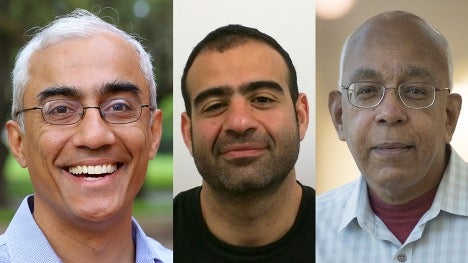Identifying a new security threat that can be used in attacks on encrypted wireless networks led to a best paper award for a team of researchers in Rice University’s Department of Electrical and Computer Engineering and the Army Research Labs. Their work, “Unsupervised Wireless Diarization: A Potential New Attack on Encrypted Wireless Networks,” was recognized as the best Communication and Information System Security paper for the 2023 IEEE’s International Conference on Communications (ICC).
“Security in communicating over wireless networks is of fundamental importance to Army operations,” said Ashutosh Sabharwal, Rice’s Earnest Dell Butcher Professor for and Department Chair for ECE. “Encrypting network data traffic is often considered sufficient to deter any malicious eavesdropping. However, with the rise of Artificial Intelligence-based ideas, the new threat is whether AI can be used to open new security threats and that was the genesis of our project.”
At its simplest, the threat is similar to an interloper listening to conversations in an unknown language over an old-fashioned telephone party line. The adversary may not know what is being said, but it can identify which party is speaking and assign that party a label. At the end of the day, the eavesdropper knows which parties sent communications and when.
“In our encrypted wireless network scenario, a passive adversary can infer which overheard packets belong to which transmitters without accessing the MAC headers. Our model, called unsupervised wireless diarization (UWD), is the foundation for UWDNet --a wireless diarization pipeline we developed to demonstrate the feasibility of this kind of AI-based attack,” said Ananthram Swami, the senior research scientist for network science in the US Army DEVCOM Army Research Laboratory.
“Speech processing researchers already use speaker diarization to label who spoke –and when– in speech recordings. The problem of identifying speakers in recordings is similar to the threat we were researching, so it was natural to envision a pipeline similar to speaker diarization in our scenario.”
Rice ECE postdoctoral research associate Nicolas Barati said their model was evaluated on both synthetic datasets and datasets of real wireless transmissions collected using RENEW, Rice’s configurable massive multiple-input multiple-output (MIMO) testbed. The RENEW testbed is the world’s first fully programmable and observable wireless radio network and was established as an open-source platform to support research like UWDNet. It is also one of the resources that drew Barati to Rice’s ECE Department.
He said, “The research work here is highly rewarding. There are so many opportunities for growth but also for discovering new research areas leading to innovation. The unique combination of world-class academic talent and technical resources such RENEW, along with steadfast support and guidance from my advisor and collaborators, have made the UWDNet project and these results possible.”
Only a massive MIMO testbed could support the kind of threat testing the Rice-ARL research team envisioned. Unlike the simple telephone party line analogy, the newly AI attack would include rapid analysis of huge data sets to infiltrate the security of encrypted wireless network communications. Sabharwal said, “We have demonstrated an AI-based adversary could infer things about networks that were thought to be not possible before. Our next step is to understand how we can protect against such attacks. It is turning out to be an AI versus AI battle.”
Swami said, “Our initial results, introductory for this novel threat vector, show that the interplay between the channel and hardware impairments can be exploited to diarize overheard transmissions – at least in the short term. This creates an open landscape for future research to create more robust labels, but also to devise defense mechanisms to counter an adversary with diarization capabilities.”
Barati looks forward to expanding on their initial findings. He said UWDNet proved the importance of role channel differentiation in labeling incoming transmissions, but the channel itself is transient. Its effect harms the robustness of the obtained device RF fingerprints, making them time- and location-dependent.
“We would like the radio frequency (RF) fingerprints that are used to label transmission to be free of the channel and include only stable RF variations idiosyncratic to each device, regardless of where they are deployed and when the transmissions occur,” he said. “To minimize the channel effect and achieve high robustness, an extension of our work could either use adversarial training or remove the channel completely."
“Adversarial training would be training UWDNet with many possible channel variations and perturbations so that UWDNet becomes indifferent to the channel variations. One way to accomplish removing the channel would be obtaining data in an anechoic chamber. In both cases, a pipeline such as UWDNeT would be nudged towards the stable characteristics present in every transmission rather than the stronger channel effects.”
The team looks forward to sharing their findings with colleagues at the 2023 IEEE ICC in Rome. Sabharwal said, “ICC is one of the biggest communications conferences, and contributions span a very wide spectrum. It is always heartening to see that our ideas are considered innovative by our peers.”
Barati feels it is a great honor to have a paper accepted at ICC, which is an IEEE Communication Society flagship conference. The added prestige of receiving a best paper award was even more exciting.
He said, “For us, this award is the culmination of a three-year long effort and we feel very pleased to see our work being recognized by our peers in the research community. We also feel delighted because we have opened a new research area in wireless security. This best paper award and the recognition are indications of the interest in this new research area and that new exciting results in this field are afoot.”
Collaborators and co-authors of the paper include Eric Graves, a civilian research scientist in the ARL, and Rice ECE Ph.D students Bishal Lamichhane and Siyu Liao. Lamichhane presented the team’s paper at the conference.

